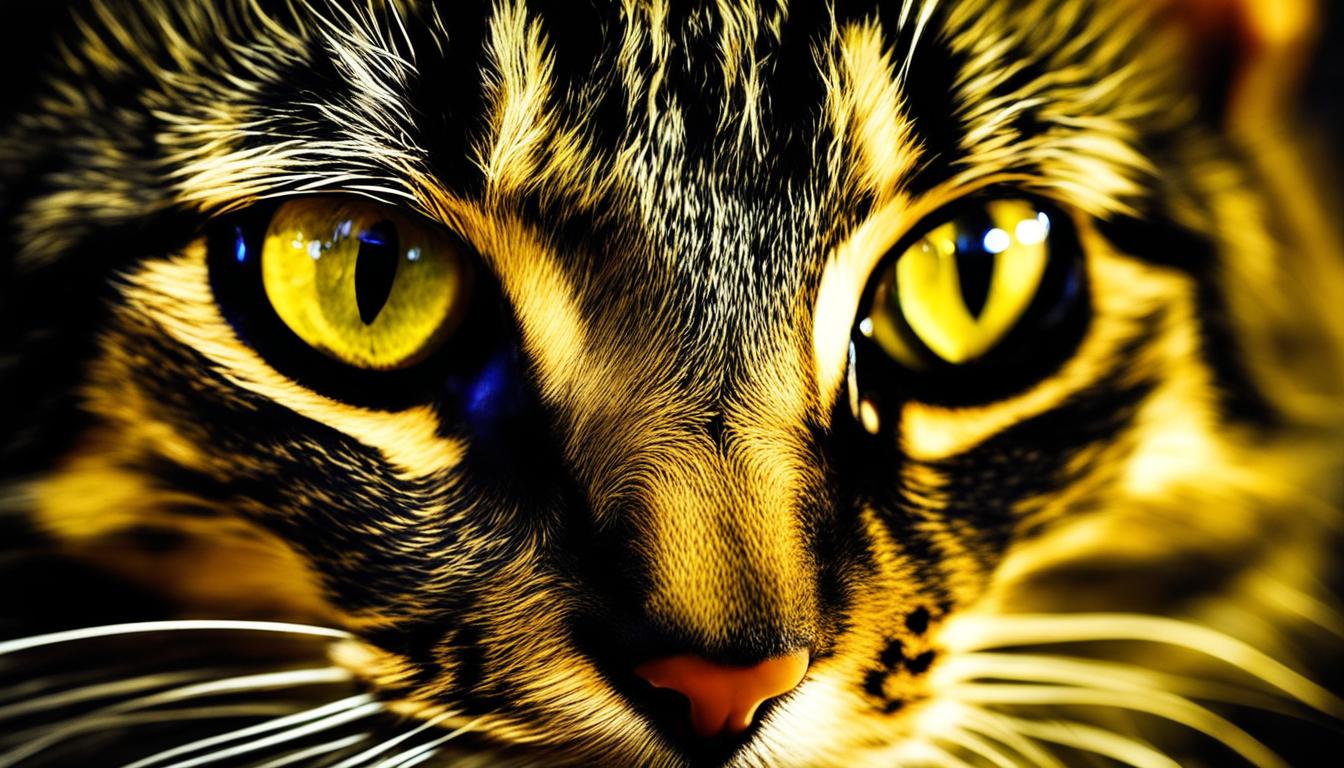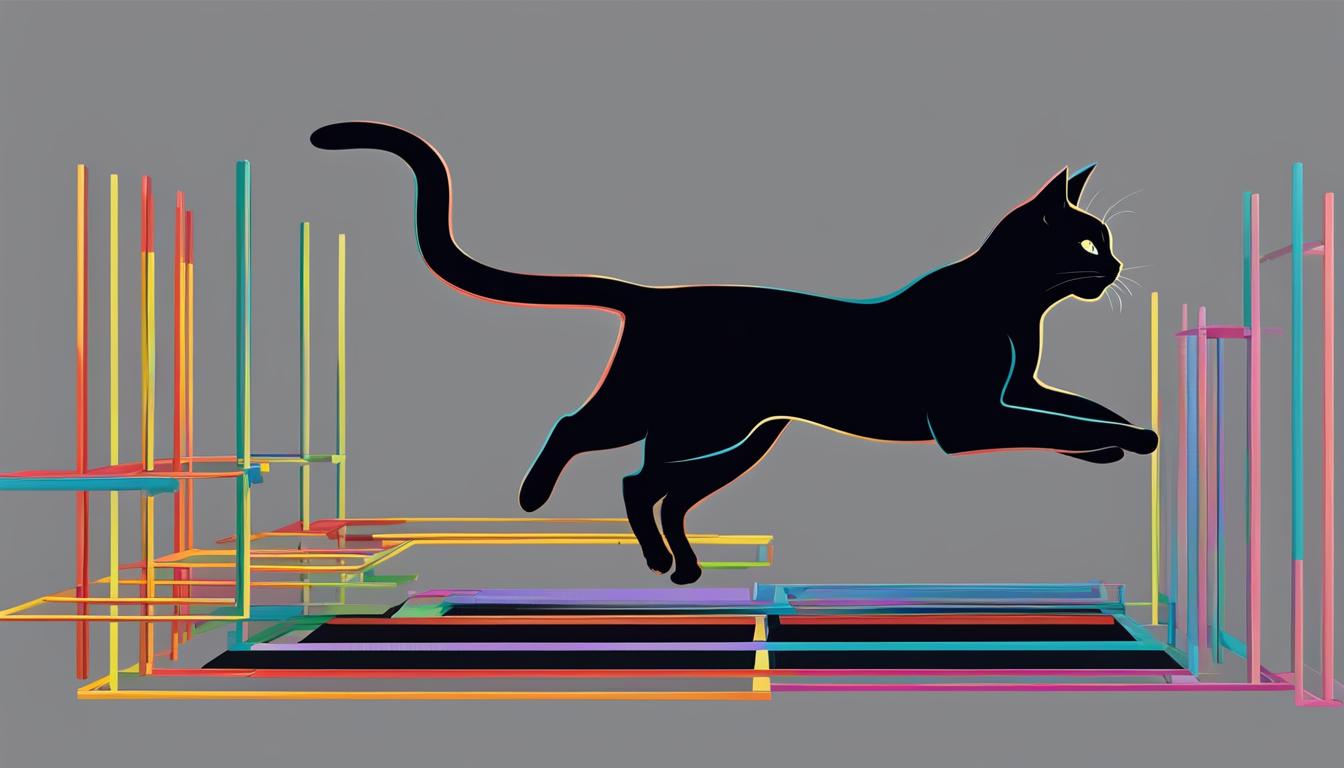Curious about how cats can see so well in the dark? I’ve always been amazed by their ability to navigate effortlessly in low light conditions, so I decided to delve into the fascinating world of cat night vision biology. Join me on this journey as we uncover the secrets behind their exceptional eyesight.
Key Takeaways:
- Cats have unique visual attributes that contribute to their exceptional night vision.
- The tapetum lucidum, a specialized layer behind the retina, plays a crucial role in enhancing cats’ ability to see in the dark.
- Cats’ night vision adaptations are essential for their hunting success and survival.
- Understanding and supporting your cat’s vision health is crucial for their overall well-being.
- Creating a cat-friendly environment and providing regular veterinary care can help maintain optimal vision health.
The Science Behind Cats’ Night Vision
Have you ever wondered how cats are able to navigate effortlessly in the dark? It all comes down to their exceptional night vision, which is rooted in their unique eye anatomy and function. At the core of cats’ superior ability to see in low light conditions lies a specialized structure called the tapetum lucidum. This remarkable layer, located behind their retina, acts like a mirror, reflecting light back through the photoreceptor cells.
The tapetum lucidum plays a vital role in enhancing cats’ night vision by amplifying the incoming light and giving their photoreceptor cells a second chance to capture the light particles. This not only allows them to see clearly in dimly lit environments, but it also enhances their contrast perception, making objects stand out more prominently against the background.
Furthermore, cats’ eyes are equipped with a higher number of rod cells compared to humans. Rod cells are responsible for low-light vision and are highly sensitive to even the smallest amount of light. Combined with their wider field of view, which enables them to scan their surroundings more efficiently, cats are adept at tracking and capturing their prey, even in the darkest of nights.
Table: A Closer Look at Cat Eye Anatomy
| Feature | Description |
|---|---|
| Tapetum Lucidum | Specialized layer behind the retina that reflects light back through the photoreceptor cells, enhancing cats’ night vision |
| Rod Cells | Responsible for low-light vision, cats have a higher number of rod cells compared to humans |
| Wider Field of View | Allows cats to scan their surroundings more efficiently, aiding in tracking and hunting prey |
So, the next time you see your feline friend effortlessly maneuvering through the darkness, remember that their exceptional night vision is a result of their unique eye adaptations. From the tapetum lucidum to the abundance of rod cells and wider field of view, cats’ eyes are finely tuned to excel in low light conditions, enabling them to see in the dark with unparalleled clarity and precision.
Adaptations for Night Hunting: Unleashing the Feline Hunters
As the sun sets and darkness descends, cats come alive with a keen sense of purpose. Their hunting instincts are unleashed, honed by millions of years of evolution. Equipped with exceptional night vision, cats possess a range of adaptations that give them a distinct advantage in the dark. Let’s delve into the fascinating world of nocturnal hunting behavior in cats and explore the evolutionary advantages of their remarkable vision.
Tracking Prey with Precision
Cats are masters of stealth, and their eyes play a crucial role in their hunting prowess. With their remarkable night vision, cats can detect even the slightest movements in their surroundings. Their eyes are finely tuned to track and respond to the faintest flicker of movement, allowing them to pinpoint potential prey even in low light conditions.
One key adaptation that aids in their hunting success is cats’ excellent depth perception. This depth perception is crucial for accurate pouncing, allowing cats to calculate precise distances and angles. Their eyes have evolved to provide a three-dimensional view of their environment, enabling them to strategize and execute their hunting techniques with precision.
Expanding the Field of View
Another evolutionary advantage of cat vision is their wider field of view compared to humans. While humans have an approximate field of view of 180 degrees, cats boast a field of view of around 200 degrees. This wider field of view allows cats to scan their surroundings more efficiently, keeping a vigilant eye on potential prey and potential threats.
Combined with their exceptional night vision, the wider field of view gives cats an edge when it comes to detecting movement and capturing prey. It allows them to survey a larger area without the need to move their head or eyes extensively, making them even more efficient hunters in the dark.
A Fascinating World Unveiled
Cats’ night vision adaptations not only enable them to survive in the wild but also provide a glimpse into their captivating world. With their ability to see clearly in low light conditions, cats navigate the darkness effortlessly and uncover hidden treasures that elude human perception.
As we continue to unravel the mysteries of feline night vision, it becomes clear that cats’ exceptional visual abilities are key to their survival and evolutionary success. From tracking prey with precision to expanding their field of view, these adaptations showcase the remarkable nature of our feline friends and their undeniable prowess as nighttime hunters.
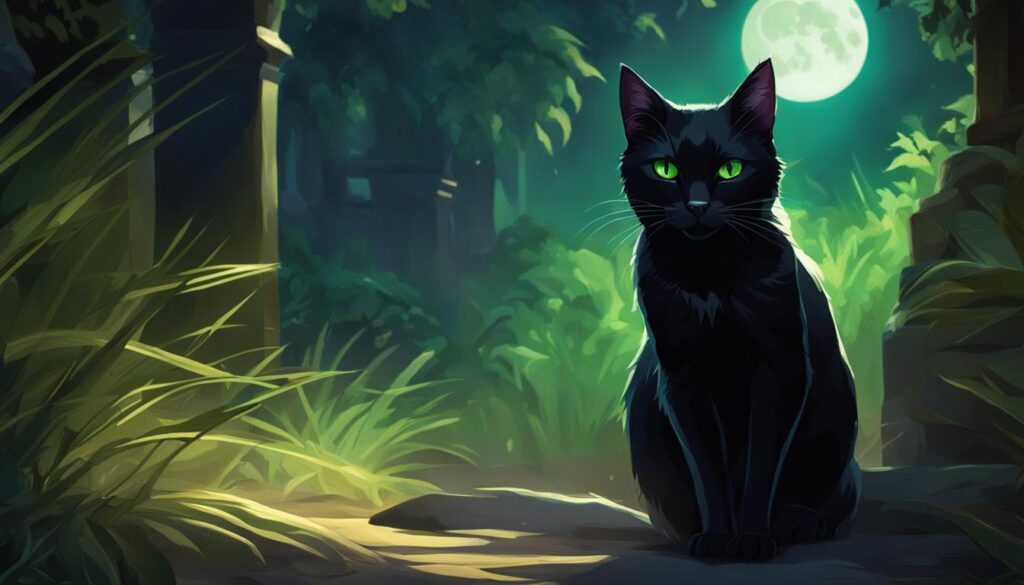
The Role of Cat Eyes in Their Nocturnal Lifestyle
Cats’ preference for nighttime activity can be attributed to their evolutionary history as nocturnal hunters. Their exceptional visual abilities play a vital role in supporting their natural instincts as nocturnal predators. Cats’ night vision allows them to navigate and explore their surroundings with ease, even in low light conditions.
As cats age, it is important to be aware of potential age-related vision problems they may encounter. Just like humans, cats can develop conditions such as cataracts, glaucoma, and age-related macular degeneration. Regular veterinary check-ups can help monitor their vision health and address any concerns that may arise.
“Cats’ exceptional night vision is a result of their unique visual adaptations, including the tapetum lucidum and a higher number of rod cells in their retinas.”
To support your cat’s vision health, it is essential to provide a stimulating environment that encourages physical activity and mental engagement. Interactive play sessions and puzzle feeders can help keep your cat mentally sharp and provide enrichment. Additionally, creating a cat-friendly environment with dim lighting or night lights can help cater to their visual preferences and overall well-being.
By actively caring for your cat’s visual health and well-being, you can ensure they continue to navigate their nocturnal lifestyle with confidence and ease.
Table: Common Age-Related Vision Problems in Cats
| Vision Problem | Symptoms | Treatment |
|---|---|---|
| Cataracts | Cloudy or opaque appearance in the eye, decreased vision. | Surgical removal of the cataract or medical management. |
| Glaucoma | Redness, pain, cloudiness in the eye, increased pressure. | Medication, surgery, or laser therapy to reduce pressure. |
| Age-related Macular Degeneration | Blurred or distorted vision, difficulty seeing fine details. | No cure, but management of underlying conditions and supportive care. |
Disclaimer: It is important to consult with a veterinarian for diagnosis, treatment, and proper management of any vision problems your cat may be experiencing.
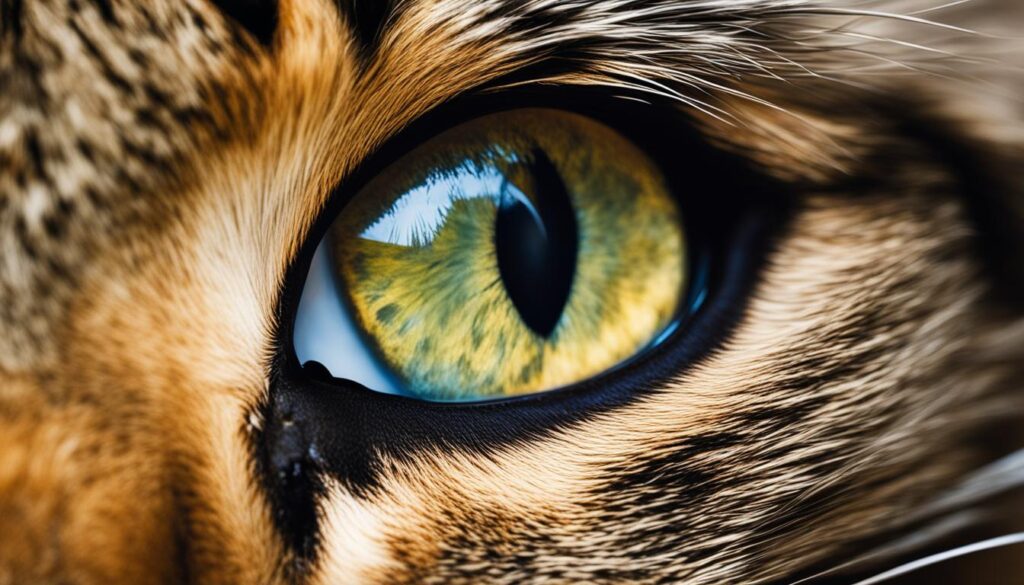
Understanding Cats’ Visual Preferences at Night
Cats’ visual preferences are a fascinating aspect of their unique sensory experience. Unlike humans, cats have specific adaptations that make them well-suited for nocturnal activities. Understanding these preferences can help us create an environment that supports their natural behaviors and enhances their overall well-being.
The Difference Between Cat and Dog Eyesight
When it comes to eyesight, cats and dogs have distinct differences. While both species have specialized adaptations for seeing in low light conditions, cats have a slight advantage over dogs in terms of night vision. This is due to the structure of their eyes and the number of rod cells in their retinas, which are responsible for detecting light.
“Cats’ exceptional night vision is a result of their unique visual adaptations.”
In comparison, dogs rely more on their sense of smell and hearing, rather than their eyesight, when navigating in the dark. However, it’s important to note that individual variations can occur within each species, and some dogs may have better night vision than others, depending on factors such as breed and genetics.
Understanding Cat Eye Reflexes
Cats’ eyes have remarkable reflexes that help them adjust to different lighting conditions. One such reflex is their ability to dilate their pupils, allowing more light to enter their eyes in low-light situations. This adaptation helps cats maximize their visual acuity in darker environments, enabling them to detect even the slightest movements.
Cats also exhibit a unique behavior called the “blink reflex.” When exposed to bright lights, such as a camera flash, cats tend to close their eyes partially or completely and then open them slowly. This reflex helps protect their sensitive eyes from excessive light and allows them to quickly adapt to changes in lighting conditions.
Creating a Cat-Friendly Environment at Night
Understanding cats’ visual preferences at night can guide us in creating a cat-friendly environment that promotes their comfort and well-being. Cats prefer dim lighting rather than bright, harsh lights, as bright lights can be overwhelming for their sensitive eyes. Consider using low-level night lights strategically placed throughout the house to provide a gentle illumination.
Engaging cats in stimulating experiences during the dark hours is also essential. Interactive play sessions using toys that mimic prey can satisfy their natural instincts and help keep them mentally and physically active. Puzzle feeders can also provide mental stimulation while satisfying their hunting behaviors.
By considering cats’ visual preferences and providing them with a cat-friendly environment, we can ensure they feel safe, comfortable, and able to fully engage in their natural behaviors, even during the nighttime hours.

Can Cats See in Complete Darkness? Debunking Common Misconceptions
When it comes to cat night vision, there are several common misconceptions. One of the most prevalent is the belief that cats can see in complete darkness. While it is true that cats have superior night vision compared to humans, they still require some amount of ambient light to see clearly. Their eyes have a higher number of rod cells, which are responsible for low-light vision. This allows them to see better in dimly lit environments, but they are not capable of seeing in complete darkness.
Another misconception is that cats have the same visual capabilities as humans. In reality, cats and humans see the world quite differently. While humans have a higher number of cone cells, which are responsible for color vision and visual acuity in well-lit conditions, cats rely more on their rod cells for better night vision. Additionally, cats have a wider field of view compared to humans, allowing them to see more of their surroundings without having to move their head or eyes. So while cats and humans both have visual abilities, they are tailored to their specific needs and environments.
Understanding these differences in vision between cats and humans can help us better appreciate and accommodate our feline friends’ needs. It is important to provide adequate lighting for cats to navigate their surroundings comfortably, especially during nighttime. Creating a cat-friendly environment that includes dim lighting or night lights can help cater to their visual preferences. This can be especially helpful for older cats who may experience age-related vision problems and need more support in low-light conditions.
| Comparison of Cat and Human Vision | Cats | Humans |
|---|---|---|
| Number of Rod Cells | Higher | Lower |
| Number of Cone Cells | Lower | Higher |
| Field of View | Wider | Narrower |
Overall, cats’ night vision biology allows them to see better in low light conditions than humans, but they still require some level of ambient light. By understanding these differences and providing a cat-friendly environment, we can ensure that our feline friends have optimal vision health and can navigate their surroundings with ease.
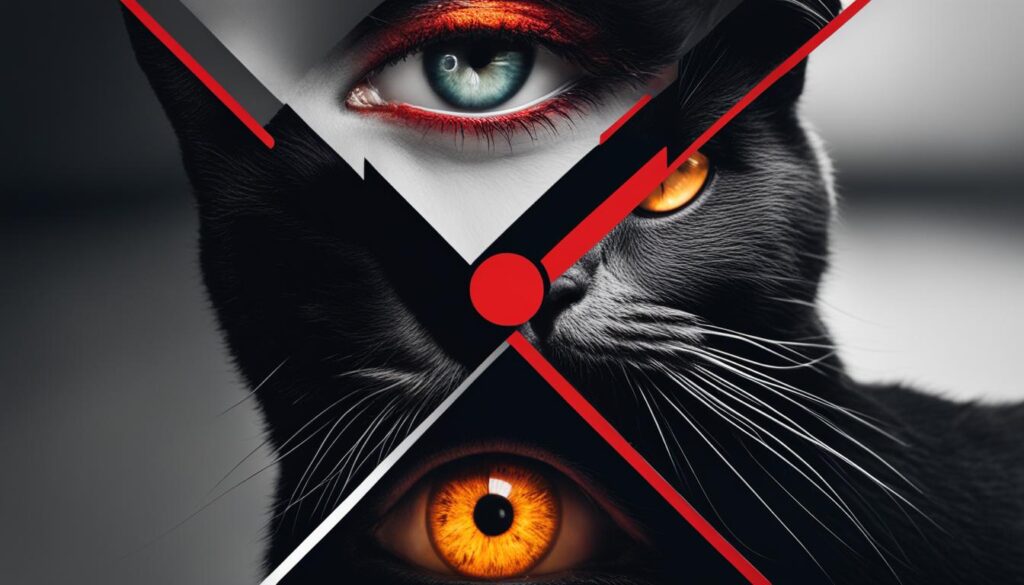
How to Support Your Cat’s Vision Health
Proper eye care is crucial for maintaining your cat’s vision health and overall well-being. Here are some feline vision health tips to help you support your furry friend:
- Schedule regular veterinary check-ups: Routine check-ups with your veterinarian are essential for monitoring your cat’s eye health and detecting any potential issues early on. Your vet can conduct thorough examinations, including checking for age-related vision problems and providing appropriate treatment.
- Create a safe and stimulating environment: Cats thrive in environments that engage their natural instincts and provide mental stimulation. Ensure your cat has access to interactive play sessions and puzzle feeders, which not only keep them mentally active but also help improve their vision by promoting better eye-muscle coordination.
- Provide proper nutrition: A balanced diet rich in essential nutrients, such as omega-3 fatty acids and antioxidants, can contribute to your cat’s overall eye health. Consult with your veterinarian to ensure your cat’s diet supports their vision needs.
- Keep their environment well-lit: While cats prefer dim lighting, it’s important to provide sufficient light to prevent accidents and help them navigate their surroundings comfortably. Consider using night lights strategically placed throughout your home to ensure they can move around safely at night.
- Monitor for signs of eye problems: Pay attention to any changes in your cat’s eyes, such as redness, excessive tearing, cloudiness, or squinting. If you notice any abnormalities, consult your veterinarian for further evaluation and treatment.
By following these feline vision health tips, you can help ensure that your cat enjoys optimal vision health throughout their life. Remember, a proactive approach to eye care is key to maintaining their well-being and enhancing their quality of life.
Table: Feline Vision Health Tips
| Tips for Supporting Your Cat’s Vision Health |
|---|
| Schedule regular veterinary check-ups |
| Create a safe and stimulating environment |
| Provide proper nutrition |
| Keep their environment well-lit |
| Monitor for signs of eye problems |
Conclusion
As I wrap up this exploration into the captivating world of cat night vision, it’s clear that our feline friends are truly remarkable creatures. Their superior sight in the dark is not just a product of chance, but a result of intricate biological adaptations.
One of the key factors contributing to their exceptional night vision is the tapetum lucidum, a reflective layer behind their retina. This ingenious structure gives cats a second chance to capture light particles, enhancing their ability to see in low light conditions. Furthermore, their higher number of rod cells, responsible for low-light vision, provides them with an edge over us humans.
If you want to support your cat’s vision health, there are a few tips to keep in mind. Regular veterinary check-ups can help identify any age-related vision problems early on. Creating a stimulating environment with interactive play sessions and puzzle feeders can engage their natural instincts and promote overall well-being. And don’t forget to consider their visual preferences by providing dim lighting or strategically placed night lights.
So, next time you catch your feline companion effortlessly navigating the darkness or mesmerized by their glowing eyes, take a moment to appreciate the incredible world of cat night vision. By understanding and caring for their visual health, you can help ensure that they continue to thrive and explore the world with their uniquely superior sight.
FAQ
What is the tapetum lucidum and how does it contribute to cats’ night vision?
The tapetum lucidum is a specialized layer behind cats’ retina that acts like a mirror, reflecting light back through the photoreceptor cells. It enhances their ability to see in low light conditions by giving the photoreceptor cells a second chance to capture light particles and amplifying the contrast of objects.
How do cats’ eyes allow them to detect movement in the dark?
Cats’ eyes are finely tuned to track and respond to even the slightest flicker of movement. Their exceptional depth perception and wider field of view enable them to pinpoint potential prey and accurately pounce on them, even in low light conditions.
Why are cats more active at night?
Cats are descendants of nocturnal hunters, and their visual preferences are strongly influenced by their evolutionary history. Their exceptional night vision allows them to navigate and explore their surroundings with ease, making them more active during the darker hours.
Can cats see in complete darkness?
No, cats cannot see in complete darkness. However, their superior night vision enables them to see better in low light conditions than humans. Cats have more rod cells in their eyes, which are responsible for low-light vision, giving them an advantage in dimly lit environments.
How can I take care of my cat’s vision health?
Regular veterinary check-ups are essential to monitor for any age-related vision problems. Creating a stimulating environment with interactive play sessions and puzzle feeders, providing a cat-friendly environment with dim lighting or night lights, and allowing safe outdoor access can all help support your cat’s visual health.
What are some tips for understanding and catering to cats’ visual preferences at night?
Cats’ visual preferences are influenced by lighting conditions. Bright lights can be overwhelming, so it is important to provide dim lighting or use strategically placed night lights. Engaging cats in stimulating experiences during the dark hours, such as interactive play sessions and puzzle feeders, can also satisfy their natural instincts and provide enrichment.

